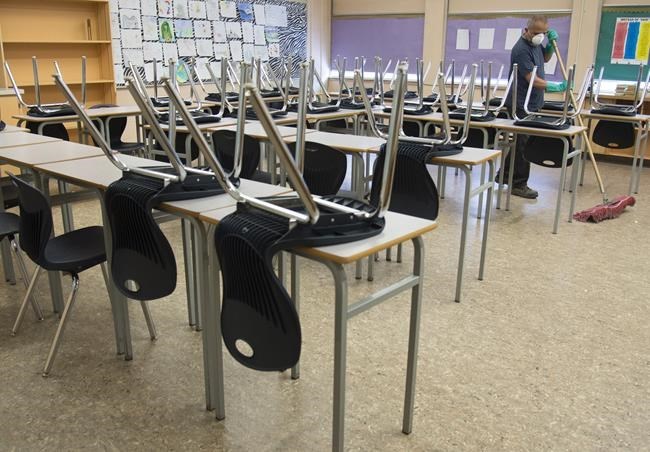TORONTO — About 55,000 Ontario education workers such as administration staff, librarians, early childhood educators and custodians could soon be in a legal strike position.
The Canadian Union of Public Employees has requested what's known as a "no board" report, signalling that talks with the government are at an impasse. If the conciliator issues a no board report, it puts the union in a legal strike position in 17 days. Here's a look at the major issues at play:
Wages are a key issue in this round of bargaining. What is each side proposing?
The union is asking for increases of $3.25 an hour in each year of the agreement, which works out to about 11.7 per cent annually on average. It says its workers earn $39,000 on average and have fallen behind after years of wage freezes and legislated caps on wage increases. The government says the gap between education workers and the rest of the sector has widened, and it proposes two per cent increases in each year for people making less than $40,000 and 1.25 per cent annual increases for everyone else.
What are some of CUPE's other major proposals?
In addition to the salary increases, CUPE wants wage grids eliminated so that all employees are paid the same rate, wants all casual and temporary employees paid the same as permanent employees, and for overtime to be paid at two times the regular rate. The union says it is proposing many such items in order to standardize terms for local units across the province, and is asking for minimum vacation entitlements dependent on years of service for that same reason. It wants employees whose "core duties are directly related" to student instruction — such as educational assistants and ECEs — to get 30 minutes of paid prep time a day. It also wants an extra week of paid work before the start of the school year. The union wants to see an increase in benefits due to inflation and an aging membership, and for casual employees to be included.
What are the associated costs?
The government says CUPE's proposals are not fiscally sustainable and would equal a 52 per cent increase in compensation. That figure includes not just wage increases, but also CUPE proposals on overtime pay, preparation time, an extra week of work, and professional development. The government says all of CUPE's measurable proposals — the province says it can't determine the cost of some items such as eliminating wage grids and standardizing vacation entitlements — would total more than $4 billion. If the same terms are applied to the deals for all four major teachers' unions as well, which usually happens in education bargaining, the government says that additional cost equals $21.8 billion over three years.
What is the government proposing?
Other than the proposal on wages, its offer seeks to keep all other areas the same as the previous deal except for a cut to sick leave pay. The government wants to institute what it's calling a five-day "waiting period" for short-term disability during which a worker would receive 25 per cent of their normal pay. After that, the rest of the 120 days of short-term disability would be paid at 90 per cent. The government also wants changes to the short-term disability application process. The regular 11 paid sick days would be maintained at full pay.
What else is CUPE looking for?
The union wants an allotment of two unpaid days converted to paid days off, an ECE in every kindergarten class regardless of size — right now it is only required if there are at least 15 kids in the class — standard bereavement leave, professional development for all workers, language on job security and for an Education Worker Protection Fund to be maintained and increased to account for wage increases.
What happens next in the bargaining process?
If and when the conciliator issues a no board report, the union will be in a legal strike position in 17 days. It also must give five days' notice of any strike action. The notice can be given during or after that 17-day period. Unions don't necessarily start job action with a full strike — they could first implement a work-to-rule campaign or do rotating strikes, for example. Whether or not schools close would depend on the level of job action and the decision would ultimately rest with school boards. But the union still has two more days of bargaining scheduled, on Monday and Tuesday, and it is hoping the looming possibility of a strike pressures the government to make moves on key items.
This report by The Canadian Press was first published Oct. 12, 2022.
Allison Jones, The Canadian Press


